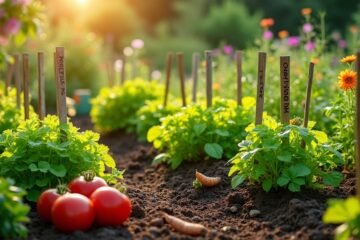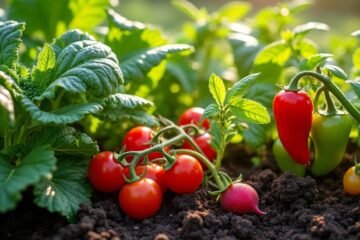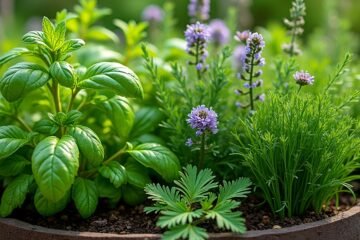Want a garden that’s bursting with flavor and color? First, pair compatible plants like basil with tomatoes for a deliciously vibrant combo! Consider growth habits, too—don’t let towering sunflowers cast shade on your petite blooms. Make use of vertical space with climbing sweet peas, while rich, loamy soil keeps your plants happy. Finally, keep an eye on watering; those thirsty babes need the right balance! Stick around for tips that’ll make your container garden irresistible!
Choose Compatible Plant Pairings

When you’re planning your garden, it’s like putting together the perfect playlist—every plant needs the right vibe to thrive! Start with herb pairings that groove together. For instance, basil loves hanging out with tomatoes, boosting flavor and growth. Imagine a mix of zesty scents wafting through your space!
Now, let’s not forget flower combinations! Marigolds and nasturtiums are like that friend who keeps the party lively, attracting beneficial insects and keeping pests away. Try groupings like lavender and rosemary for a touch of elegance, all while creating a fragrant sanctuary. You’re composing a living masterpiece, where each duo harmonizes beautifully. Explore varieties and witness the magic unfold—after all, your garden deserves a spotlight!
Consider Plant Growth Habits
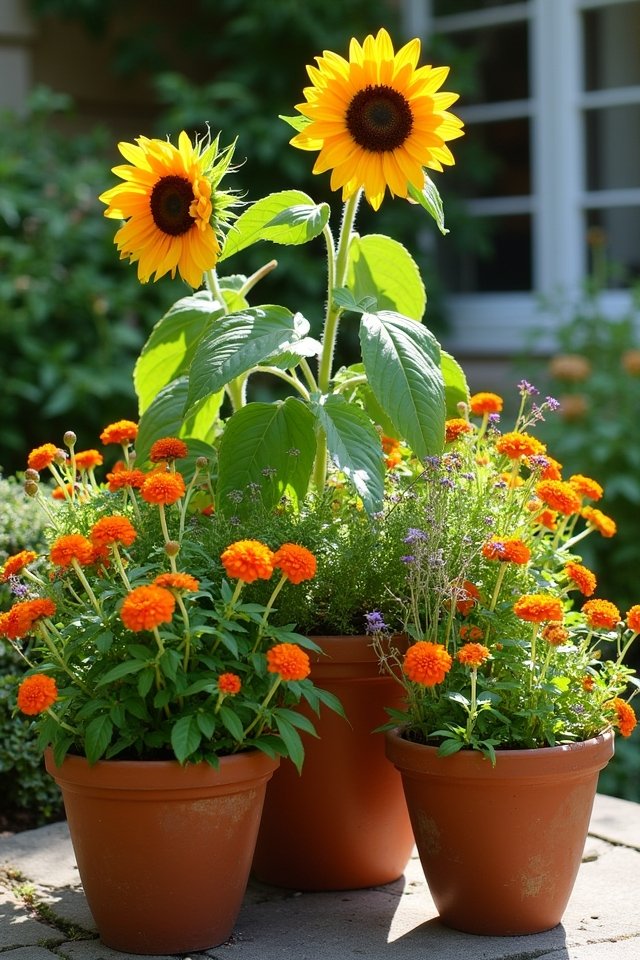
As you mix and match those delightful companion plants, it’s just as important to contemplate how each one likes to grow. Imagine your tall sunflowers towering over their shorter friends like protective giants! Pay attention to their plant height and growth rate. Fast-growing plants, like radishes, can quickly outpace slower ones, like lavender, which can lead to chaos in your cozy container. You don’t want a jungle where your delicate herbs get smothered! Instead, consider pairing a lush leafy vegetable, like kale, with petite flowers, letting them bask in the same space without competing for the spotlight. Be the maestro of your miniature garden symphony—every plant has a role, so choose wisely to create a harmonious, thriving container!
Utilize Vertical Space
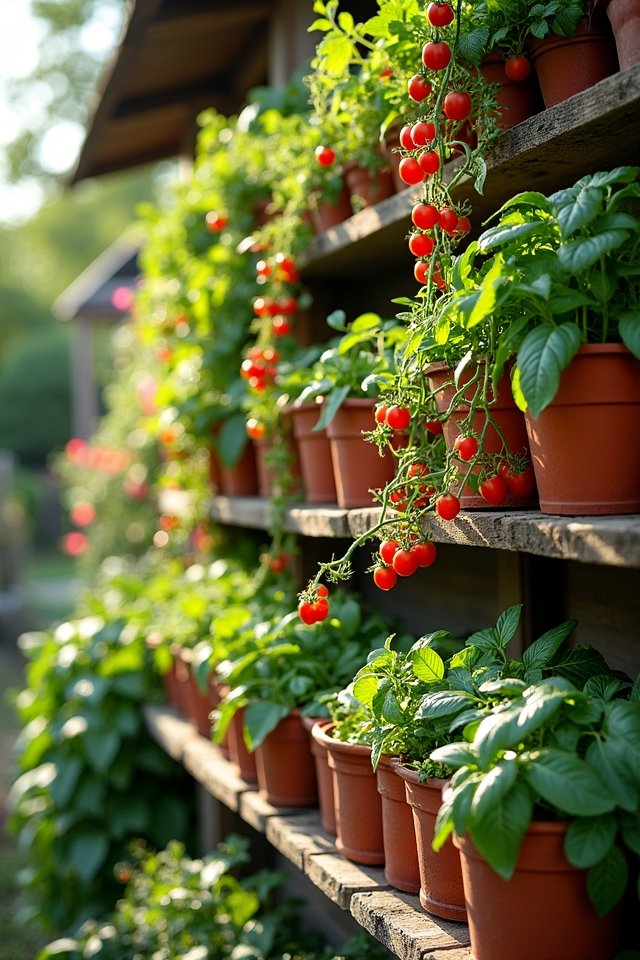
How can you maximize your gardening space without turning your yard into a sprawling jungle? Adopt vertical gardening! Utilizing climbing plants, like sweet peas or morning glories, can transform your containers into lush, green towers of joy. With a variety of trellis options, from simple bamboo stakes to elaborate latticeworks, you can easily support your green companions and create a dramatic effect in your space. Picture vibrant blossoms reaching for the sun while trailing plants cascade down the sides! It’s a win-win; you’ll save room while also creating a stunning display. Plus, who doesn’t love a little height in their garden? So, get ready to elevate your planting game—literally! It’s time to think vertically!
Mind Soil and Nutrient Needs
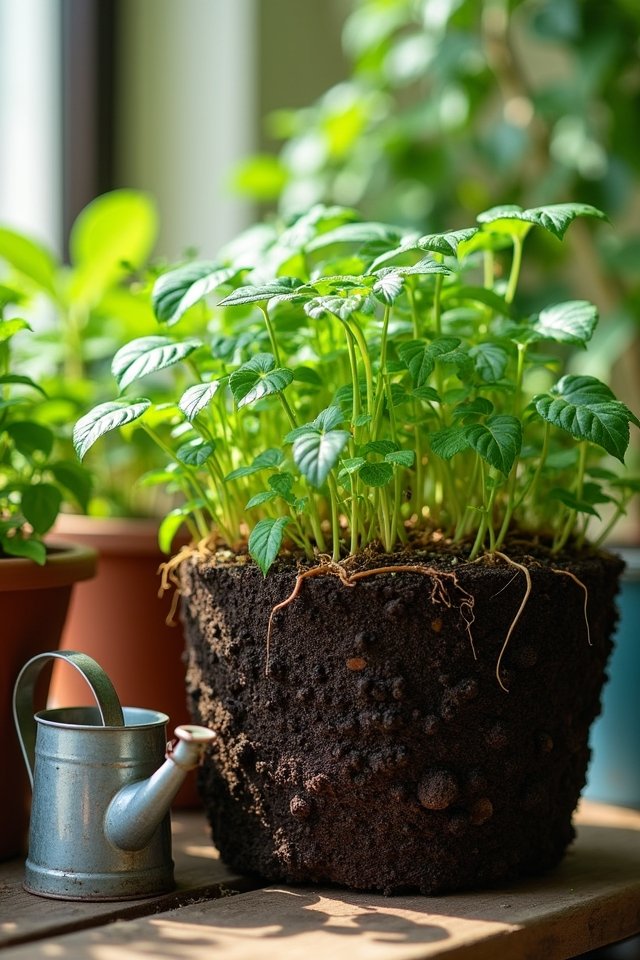
You’ve got your plants climbing high, but don’t forget about what they’re growing in—soil! It’s like a cozy blanket, and the right soil composition is key. Think rich, loamy goodness with good drainage and aeration—the perfect playground for roots! When you mix in organic matter, like compost, you boost nutrient balance, giving your plants that extra kick they crave. Imagine your veggies dancing with joy as they soak up those essential vitamins! By blending these components thoughtfully, you set them up to thrive in their confined oasis. So, get innovative: layer your soil with all those goodies and help your plants shine brighter than a summer sun! After all, happy roots equals fabulous fruits—it’s a match made in green heaven!
Monitor Watering and Drainage Requirements
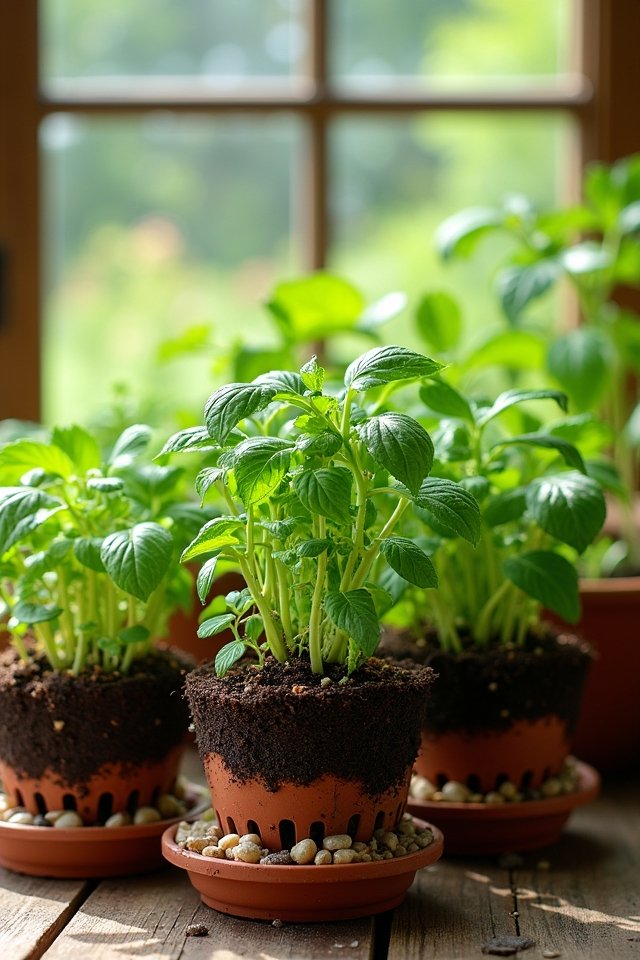
Watering and drainage are two peas in a pod when it comes to keeping your garden lush and vibrant! Your container plants need just the right balance of water retention and drainage solutions to flourish. Overwatering can drown your plants faster than a sinkhole, so make sure you’ve got holes at the bottom of your pots for that pesky excess water to escape!
Consider using potting mixes designed for containers; they often have ingredients that help retain moisture, but still allow draining. Try adding materials like perlite or vermiculite for a boost! And don’t forget to touch the soil—if it feels dry an inch down, it’s time for a drink. Remember, your plants are counting on you to quench their thirst!
Frequently Asked Questions
Can I Use Seeds for Companion Planting in Containers?
Absolutely, you can use seeds for companion planting in containers! When you’re choosing, look for seeds that thrive well together, like tomatoes and basil; they practically chat all summer long! Experiment with container varieties, mixing herbs and veggies for both aesthetics and flavors. Imagine your patio bursting with colorful blooms and tasty harvests. Who said gardening can’t be playful? Immerse yourself, and watch your mini ecosystem flourish! It’s the ultimate garden party!
How Do I Prevent Pests in Container Companion Planting?
Imagine your container garden as a bustling city, where natural predators are the superhero protectors! To prevent pests, introduce pest deterrents like basil near tomatoes or marigolds that act like tiny shields. You can also invite ladybugs or lacewings—they’ll munch on pesky aphids. Keep your garden well-watered but not soaked, because bugs love a soggy sponge! Who knew your container could be an oasis of innovation and a fortress at the same time?
Are There Any Plants to Avoid When Companion Planting?
When you’re diving into companion planting, watch out for those plants to avoid! For instance, tomatoes and potatoes make an unlikely couple, much like oil and water. They just can’t coexist well! Similarly, mint can choke out basil, turning your garden into a sneaky wrestling match. Don’t let incompatible pairings ruin your planting dreams! Keep your garden harmonious, and pick friends wisely for a vibrant, pest-free paradise. Happy planting, friend!
Can Companion Plants Affect the Taste of Fruits and Vegetables?
Companion plants can jazz up the taste of your fruits and veggies like a sprinkle of magic! For instance, basil’s aromatic charm can elevate tomatoes’ flavor profile, making them burst with sweetness! You’ll savor each bite more, thanks to this dynamic duo. Imagine biting into strawberries alongside mint—talk about a flavor explosion! So, don’t just plant; be a flavor alchemist! Your garden’s beauty is in taste enhancement. Enjoy every delicious moment!
How Often Should I Rotate Companion Plants in Containers?
You should rotate your companion plants every few weeks, especially in smaller containers. Think of it like a dance party for your plants! Change things up to keep the soil happy and nutrients flowing. If you’ve got a large pot, every 4-6 weeks works well. Just remember, some plants are picky—carrots and onions are great friends, while tomatoes might get jealous! Give them space to shine, and you’ll harvest delicious results!
